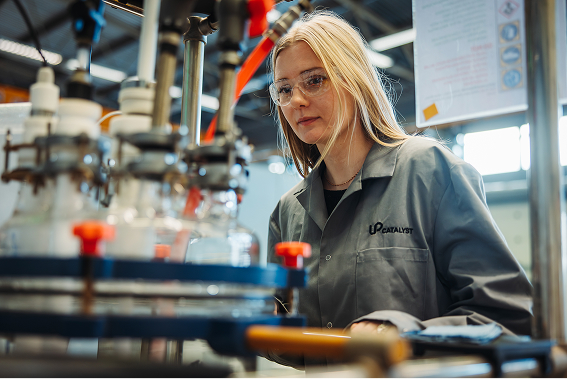Technology
UP Catalyst uses Molten Salt Carbon Capture and Electrochemical Transformation (MSCC-ET) technology for the production of climate neutral carbon materials. CO₂ from industrial emissions is pulled into the molten salt synthesis reactor. With the molten salt heated to 750 degrees Celsius working as an electrolyte, CO₂ undergoes the process of electrolysis. A voltage difference applied to electrodes kick-starts the process of breaking down the CO₂ molecules. As a result, oxygen is released, with carbon being collected and then purified.
UP Catalyst carbon materials do not bring new CO₂ into the atmosphere as they are produced directly from CO₂ emissions and the process is powered by green electricity.

UP Catalyst production process requires 40% less energy than conventional synthetic graphite production.
To produce carbon nanotubes, UP Catalyst production process requires 90% less energy. That ensures low carbon material costs, compatible with fossil-based carbon materials.
UP Catalyst carbon materials are climate neutral and do not bring new CO₂ into the atmosphere. The cradle-to-gate LCA was conducted by Research Institutes of Sweden (RISE) and critically reviewed by Bureau Veritas Poland and Estonia offices.
To synthesize one ton of carbon materials, we need 3.7 tons of gaseous CO₂ and only green electricity as main components.
UP Catalyst strengthens the resilience of carbon material supply chains by enabling local production. This reduces reliance on imported synthetic and natural graphite anode materials, as well as carbon nanotubes, significantly shortening supply chains and mitigating geopolitical risks. According to the International Energy Agency, graphite faces some of the highest geopolitical risks among critical raw materials.
Thanks to a production process that relies solely on CO₂ and green electricity, UP Catalyst can establish facilities in diverse locations worldwide, further enhancing global supply chain flexibility.
UP Catalyst carbon materials are climate neutral and do not bring new CO₂ into the atmosphere. The cradle-to-gate LCA was conducted by Research Institutes of Sweden (RISE) and critically reviewed by Bureau Veritas Poland and Estonia offices.
To synthesize one ton of carbon materials, we need 3.7 tons of gaseous CO₂ and only green electricity as main components.

UP Catalyst's research into producing carbon materials through molten salt electrotransformation technology began over a decade ago at the University of Tartu, Estonia, followed by establishing UP Catalyst in 2019. Over the past few years, we have successfully scaled our technology from laboratory gram-scale reactors to a pilot production facility in Maardu, Estonia. Our current reactor unit can synthesize 10 kg/day of multi-walled carbon nanotubes (MWCNTs).
According to our scale-up plan, by 2030, UP Catalyst will construct a large-scale facility with an annual production capacity of 60,000 tons of carbon materials—enough to power over 1 million electric vehicles. Once the first large-scale facility is operational, subsequent facilities can be easily replicated, co-located with CO₂ emitters, and positioned to supply sustainable graphite across the EU.
Production: 270 kg/yr
CO₂ extraction:1 t/yr
2.7 t/yr
10 t/yr
27 t/yr
100 t/yr
270 t/yr
1 kt/yr
1.6 kt/yr
6 kt/yr
60 kt/yr
222 kt/yr
